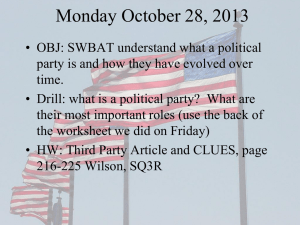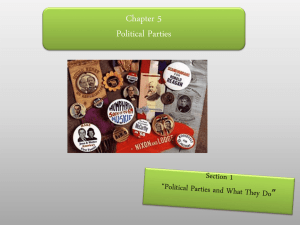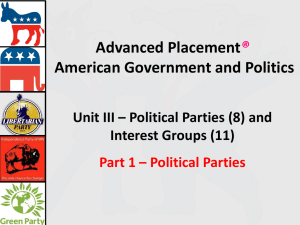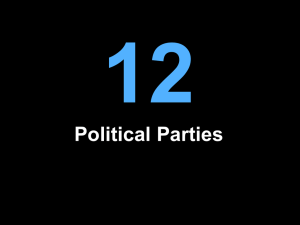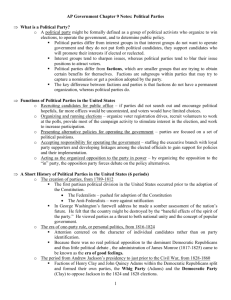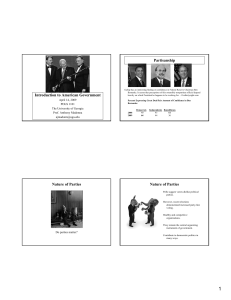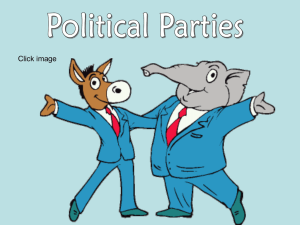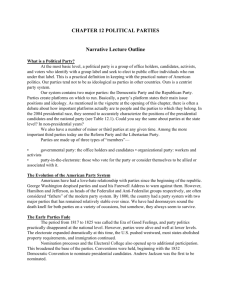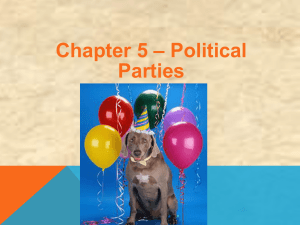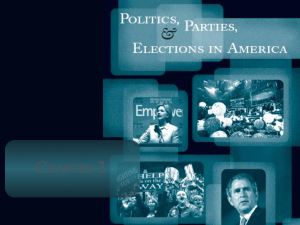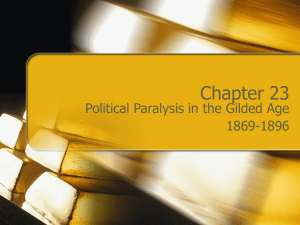2011 chapter8 - Kenston Local Schools
advertisement
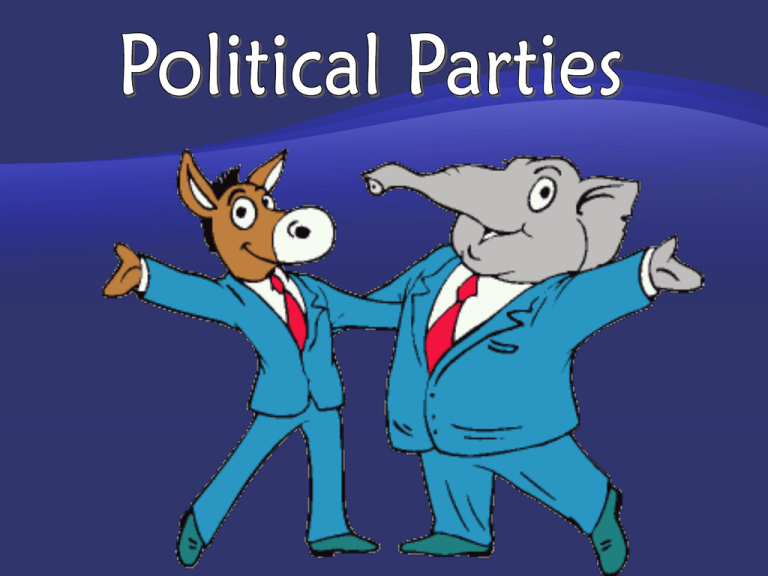
Political Party: A group of persons joined together on the basis of common principles who seek to control government the winning of elections. There are two major parties in American politics today: Democrats & Republicans Some argue this does not fit the American version… the Democrats and Republicans are election oriented, not principle/issue oriented. Political Parties & Their Functions Some believe American politics would function better without political parties Others say political parties necessary for democratic government, but at the same time, do not trust them Kind of a “love-hate” relationship Distrust especially strong among younger voters 3 Why are Political Parties important? The are the major mechanisms behind broad policies and leadership choices. They act as a “the voice of the governed” and some argue that parties are how the will of the people are best expressed. Political parties bring conflicting groups together to find “common ground”. The soften extremist views and seek compromise and unity. What Is a Political Party? An organization that sponsors candidates for political office under the organization’s name Use a nomination process Democracies must have at least two political parties that regularly compete against each other 5 Party Coalitions Today What Is a Political Party? 7 1) Nominating Candidates: Political leadership requires certain qualities The major function is to nominate, or name, candidates for public office… and then they help them win their elections. Parties can perform “quality control” by choosing candidates Recruiting and choosing candidates and gathering support for them. 2) Structuring the Voting Choice Work to reduce number of candidates on ballot to those with chance of winning Loyal party voters provide predictable base of votes Third-party candidate success difficult Choice between only two parties reduces information needed by voters 9 3) Informing and Activating Supporters: Parties inform the people, spark their interest, inspire them, and get them to participate in public affairs. Voters are inspired to campaign for candidates, take stands on issues, and criticize opponents. Parties create campaign materials (buttons, posters, bumper stickers) and propaganda materials (pamphlets, TV, internet, newspaper and radio commercials, speeches, and rallies) to show their issues in the best light. 4) Proposing Alternative Government Programs Parties set out general policies candidates will pursue if they gain office Candidates tend to support party positions, although exceptions occur Some party names advertise policies, such as the Green Party, Socialist Party, and Libertarian Party America’s two major parties have relatively neutral names 11 Acting as Watchdog: Parties act as watchdogs over the publics business. The party out of power usually takes this role by criticizing the party and behavior of the party in power (in the executive branch). The party out of power tries to convince voters that they should “throw the rascals out”. The party out of power tried to become “the voice of the people” by expressing their concerns. They become “the loyal opposition”---- opposed to the party in power but loyal to the people! Coordinating the Actions of Government Officials U.S. government’s separation of powers divides responsibilities for policymaking Political parties major bridge for bringing the separate powers together to govern effectively 13 The Pre party Period Constitution does not mention political parties Only factions, not parties, existed when Constitution written Federalist No. 10 hoped federalist system would prevent factional influences Factions of the time included Tories or Loyalists, Whigs or Patriots, Federalists, and Anti-Federalists 14 The Preparty Period Elections vastly different from TODAY President and Vice President decided by electoral college Electors frequently met in private caucuses to propose candidates George Washington opposed factional politics Because of neutrality, elected unanimously 15 The First Party System: Federalists & Democratic Republicans Federalists led by Alexander Hamilton Democratic Republicans led by Thomas Jefferson Election of 1796 saw John Adams (a Federalist) elected president, with Thomas Jefferson(Dem.-Rep.) elected vice president In election of 1800, both parties nominated candidates for both president and vice president 16 Figure 8.1 The Two-Party System in American History 17 The Twelfth Amendment Election of 1800 saw top two vote-getters from Democratic-Republican Party – but tied in Electoral College! Eventually Jefferson elected president Ratification of 12th Amendment in 1804 split votes in Electoral College for president and vice president Democratic-Republicans won next four elections, then fell apart 18 The Second Party System: Democrats and Whigs Jackson’s faction of Democratic Republicans represented “common people” Preferred to be called Democrats Jackson ran for president in 1828; birth of today’s Democratic Party Increase in suffrage rights led to voters choosing presidential electors Greater numbers voting required changes from existing parties 19 Party Changes Major parties began having national conventions to select candidates and adopt party platforms First, Anti-Masonic Party in 1831; Democrats and National Republicans followed in 1832 Coalition of those opposing Jackson formed Whig Party in 1834 Democrats and Whigs alternated presidency for next 30 years 20 The Current Party System: Democrats and Republicans Antislavery forces organized Republican Party in 1854 John Fremont presidential candidate in 1856; Abraham Lincoln in 1860 Election of 1860 first of four critical elections Led to electoral realignment , with northern states voting Republican and southern states voting Democratic for decades 21 Eras of Party Dominance Since the Civil War Democrats and Republicans major parties since 1860 election Two-party system Third parties rarely successful, except at state or local level Balance of power between two major parties different in various parts of country and at different times 22 Four Political Eras Since Civil War A Rough Balance: 1860-1894 GOP (Grand Old Party, or Republicans) won eight of 10 presidential elections House and Senate wins balanced A Republican Majority: 1896-1930 Democrats in trouble because of economic depression in 1896 Republican William McKinley won presidency; Republicans basically in power until Great Depression 23 William Jennings Bryan: When Candidates Were Orators 24 Four Political Eras Since Civil War A Democratic Majority: 1932-1964 Voters unhappy with economic crisis swarmed to support Democratic candidate Franklin Delano Roosevelt in 1932 Roosevelt won election; Democratic party won majorities in both House and Senate A major electoral realignment 25 Four Political Eras Since Civil War A Rough Balance: 1968 to the Present Richard Nixon’s victory in 1968 a fourth critical election; Republican presidential candidates have done well since Congressional elections in this period mixed: Democrats generally control House, Senate control split about evenly Party loyalty within regions has shifted; possible electoral dealignment 26 The American Two-Party System While two parties are dominant, third parties make contributions also Third parties usually one of four types: Bolter parties Farmer-labor parties Parties of ideological protest Single-issue parties 27 Figure 8.2 Party Candidates for the U.S. House in the 2010 Election 28 Historical Third-Party Successes Third parties not very successful Rarely receive more than 10% of the vote Bolter parties have won more than 10% twice Republican Party originated as single-issue third party Third parties have better record as policy advocates, and serve as safety valves 29 Four types of minor parties: 1)Ideological Parties: Based on set of beliefs (social, economic, political) e.g. socialist, socialist labor, socialist worker, communist Libertarians Party is non-socialist Don’t win many votes, but have been long lived. 2. Single-Issue Parties: Concentrate on one public policy matter (usually short lived) Names indicate primary concern: Free Soil Party- end expansion of slavery Know Nothing Party (American Party) - opposed immigration, particularly of Irish Catholics Right to Life Party- opposes abortion 3. Economic Protest Parties: No clear cut ideological base, unlike socialists which focus on economic issues Focus on their “enemies” such as: Monetary system, Wall Street Bankers, railroad, foreign imports Greenback Party: (1876-1884) appealed to farmers- free silver, federal regulation of railroads, income tax, labor legislation Populist Party: (1890’s) public ownership of railroad, telephone, and telephone. Wanted lower tariffs, adoption of initiative and referendum These parties often form in times of economic turmoil- also short lived 4. Splinter/BOLTER Parties: Break away from major parties (usually short lived) “Republican Splinters”: “Bull Moose” Progressive Party: (1912) Theodore Roosevelt challenged Howard Taft’s Republican nomination called for women's suffrage recall of judicial decisions easier amending the U.S. Constitution social welfare legislation for women and children, workers' compensation limited injunctions in strikes farm relief required health insurance in industry new inheritance taxes and income taxes “Republican Splinters”: Progressive Party: (1924) Candidate Robert La Follette called for government ownership of the railroads and electric utilities, cheap credit for farmers outlawing child labor stronger laws to help labor unions more protection of civil liberties “Democratic Splinters”: States’ Rights “Dixiecrat” Party: (1948) Led by Strom Thurmond advocated retention of Jim Crow laws racial segregation. American Independent Party (1968) led by former Alabama Governor George Wallace who advocated A reversal of the Civil Rights Act of 1964 opposed to federal government welfare programs. One Party that does not fit into any category is the Green Party USA (founded 1984). Began as single issue party, but… In 2000, Ralph Nadar accepted their endorsement as President and adopted a variety of issues: environmental protection universal health care gay rights restraints on corporate power campaign finance reform opposition to global free trade more… Why a Two-Party System? U.S. two-party system results from electoral process and political socialization Elections based on majority representation, not proportional representation Major parties make election laws Presidential politics and persistence drive survival of Democratic and Republican parties 38 The Federal Basis of the Party System Party identification important political concept Most people identify with one of the two major parties Data show three tendencies: Republicans and Democrats together outnumber Independents More Democrats than Republicans Democratic numbers shrinking over time 39 Figure 8.4 Distribution of Party Identification, 1952-2008 40 Party Identification Party identification predisposes but does not mandate voting behavior Factors affecting party identification: Income Religion Region Age Education Gender Ethnicity Parental party identification also important 41 Figure 8.5 Party Identification by Social Groups 42 Fewer Citizens Are Partying Partisanship has declined since early 1950s Also true in many other democracies Reasons given include more education and political sophistication 43 Party Ideology and Organization Significant differences in ideology between Republicans and Democrats Approaches to concepts of freedom, order, and equality affect spending priorities Differences drive party platforms Ideological differences more pronounced when looking at party activists 44 Figure 8.6 Ideologies of Party Voters and Party Delegates in 2008 45 National Party Organization Some believe Republicans more organized as a party than Democrats Each party has four major organizational components: National convention National committee Congressional party conferences Congressional campaign committees 46 Building a Bigger Republican Tent? 47 National Party Organization National parties not particularly powerful Do not direct or control presidential campaigns Beginning in 1970s, Democrats made procedural changes and Republicans made organizational reforms Both parties have made significant organizational changes in recent years 48 State and Local Party Organizations At one time, both parties had powerful state and local party machines Individual organizations vary in size and strength National parties supply funding, candidate training, poll data and research, and campaigning instruction 49 Decentralized but Growing Stronger American parties one of most decentralized in the world Even though party identification dropping, political party organizations growing stronger Still, not clear how well parties link voters to government 50 The Model of Responsible Party Government Parties essential to making government responsive to public opinion in majoritarian model Parties should present clear and coherent programs to voters Voters should choose candidates based on party programs Winning party should carry out proposed programs Voters should hold governing party responsible for program execution at next election 51
